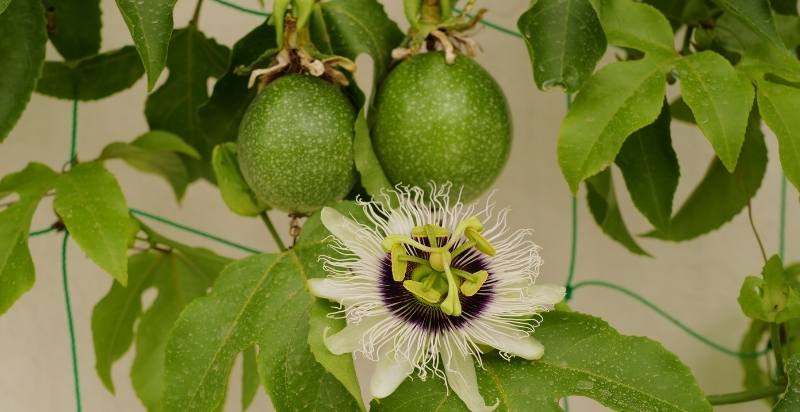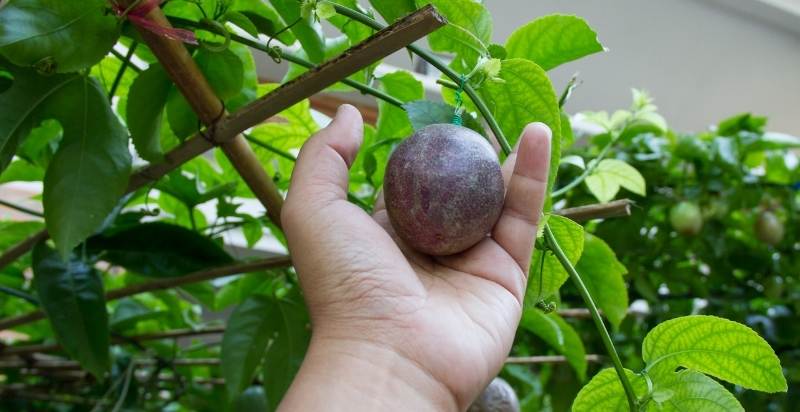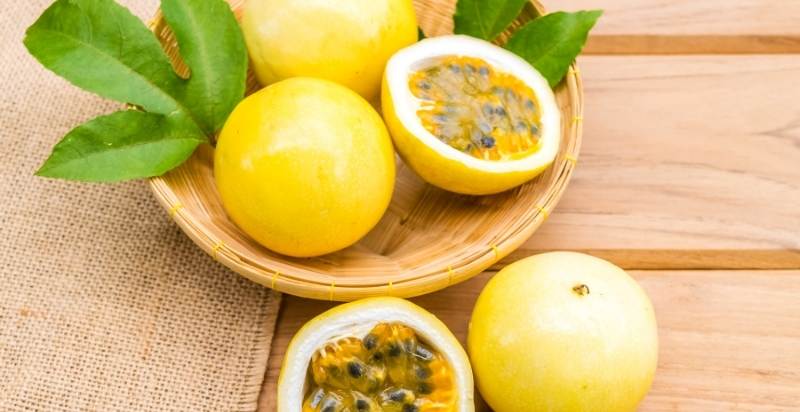Do you love the taste of passion fruit? Maybe you’ve seen them at the grocery store but have never actually tried one. Well, now is your chance! This blog post will teach you how to plant, grow, and harvest passion fruit. It is a delicious and nutritious snack that you can enjoy all year. And here’s everything you need to know about planting, growing, and harvesting it.
What is Passion Fruit: Health Benefits & Nutrition Facts
Passion fruit is a tropical fruit that is native to South America. The fruit is typically round or oval and has tough, inedible skin. It can be either yellow or purple and contains many small, black seeds. The fruit’s flesh is sweet and tart and can be used in various recipes.
Health Benefits:
It is a good source of vitamins A and C and fiber. Vitamin A is important for vision and skin health, while vitamin C helps to boost the immune system. Fiber helps to promote digestive health by keeping the bowels regular. It also contains antioxidants, which aid in shielding the body from harm caused by free radicals.
They have several potential health benefits, including:
- Boosting the immune system
- Improving vision
- Promoting digestive health
- protecting against free radical damage
- Reducing inflammation
Nutrition Facts:
One cup (100 grams) of Passion Fruit contains:
| Calories: | 116 |
| Protein: | 3 grams |
| Fat: | 1 gram |
| Carbohydrates: | 27 grams |
| Fiber: | 8 grams |
| Vitamin A: | 20% of the Daily Value (DV) |
| Vitamin C: | 73% of the DV |
Varieties Of Passion Fruit:
There are various varieties of passion fruit, each with its unique flavor. Some of the most popular varieties include:
- Purple Passion Fruit: This variety is native to Brazil and has deep purple skin. The fruit’s flesh is white or yellow and contains small black seeds. The flavor of this variety is sweet and tangy.
- Yellow Passion Fruit: This variety is native to Peru and has yellow or orange skin. The fruit’s flesh is sweet and tangy with a hint of bitterness.
- Granadilla: This variety is native to Ecuador and has green or yellow skin. The fruit’s white flesh is covered in tiny black seeds. The flavor of this variety is sweet and floral.
These vines can be either male or female. Male vines produce pollen but no fruits, while female vines produce both pollen and fruits. To ensure proper pollination, it is best to plant at least one male vine for every three to five female vines. They can also be self-pollinating, meaning that the flowers can pollinate themselves.

When to Plant Passion Fruit Vines?
The best time to plant this fruit is spring, after the last frost. They can be grown in containers or on the ground and will do best in a warm, sunny spot.
If you’re growing it in a pot, ensure it’s at least 18 inches wide and has drainage holes. Passion fruit vines need room to spread out, so choose a large pot to accommodate the plant’s growth.
How To Grow Passion Fruit From A Seed?
If you’ve ever eaten passion fruit, you know they’re delicious. But did you know that you can cultivate these from seeds with relative ease? All you need is patience and the right growing conditions, and you can enjoy fresh fruit right from your backyard.
To start, you will need to obtain some fresh passion fruit seeds. You can do this by purchasing them from a nursery or online or harvesting them from ripe fruits. Once you have your seeds, you will need to clean them off and remove any fleshy parts. This can be done by gently rubbing them with a paper towel or using a small knife to scrape any excess material.
Once your seeds are clean, you must soak them in water for 24 hours, which will help soften the outer shell and make it easier for the seed to germinate. After soaking, remove any extra water, then spread the seeds out on paper to dry naturally.
Once your seeds are dry, you can plant them in soil or a planting medium. It is best to start them indoors in pots or trays to control the environment and temperature better. Its seeds need warm temperatures to germinate, so placing them near a heat source like a radiator or sunny window can be beneficial.
Water your seeds regularly, keeping the soil moist but not soggy. Once your seedlings have sprouted, thin them out so that only the strongest and healthiest plants remain. Transplant them into larger pots or your garden once they are a few inches tall.
Passion fruit vines are generally drought tolerant, but they will produce more fruits if they are watered regularly. Be sure to fertilize your plants about once a month during the growing season to promote healthy growth and fruiting.
How To Grow Passion Fruit From A Seedling ?
Passion fruit vines are heat-loving plants that require a long, warm growing season to produce fruits. The ideal way to start your passion fruit seeds indoors and give them a head start on the growing season is if you live in a region with a short growing season.
To start:
- Fill pots or trays with a sterile seed-starting mix and moisten them well.
- Sow the seeds on the surface of the mix, and then cover them lightly with more mix or sand.
- Place the pots in a warm location – near a radiator or in front of a sunny window – and keep the soil moist but not soggy.
Once the seeds have germinated – which can take two weeks or longer – thin the seedlings so that only the strongest and healthiest plants remain, and transplant them into larger pots or your garden once they have grown to be a few inches tall.
Passion fruit vines are generally drought tolerant, but they will produce more fruits if they are watered regularly. Be sure to fertilize your plants about once a month during the growing season to promote healthy growth and fruiting.
Where To Grow Passion Fruit?
If you are growing it in a container, choose one at least 18 inches wide with drainage holes. Fill the pot with a mix of half potting soil and half sand or perlite. Plant two or three seeds near the center of the pot while the soil is damp but not soggy. After lightly covering the seeds with potting mix, place the pot in a warm, sunny location.
If you are growing it in the ground, prepare the soil by mixing some organic matter such as compost or manure. Passion fruit vines like sandy, well-drained soil, so if your soil is heavy clay, you may need to amend it with sand. Plant two or three seeds near the center of the planting area, and cover them with a thin layer of soil. Water the area well.
Passion fruit vines can also be propagated from cuttings. To do this:
- Take a 4-inch cutting from a healthy vine in late spring or early summer.
- The cutting’s lower leaves should be removed, and the cut end should be dipped in the rooting hormone.
- Place the cutting in a pot with sand or perlite, and give it plenty of water.
- Put the pot in a warm, sunny location, and make sure the soil is moist but not soggy. It should take four to six weeks for the cutting to begin to root.
Caring For Passion Fruit Vines:
Passion fruit vines are generally very low maintenance and easy to care for. However, it would be best to keep a few things in mind to ensure that your plant stays healthy and produces plenty of fruit.
- Fertilizer: Passion fruit vines are heavy feeders and need a constant supply of nutrients to produce an abundance of fruit. A well-balanced fertilizer should be applied every two to three weeks during the growing season. Passion fruit vines are also sensitive to changes in pH and prefer slightly acidic soils with a pH between 5.5 and 6.5.
- Sunlight: To produce fruit, passion fruit vines need at least six hours of direct sunlight each day, so be sure to plant them in a sunny location. They also need plenty of room to grow, so give them plenty of space when planting.
- Watering: Watering passion fruit vines is essential, and they should receive both deep and frequent waterings, particularly during the hottest months of the year. It is important to keep the soil dry out completely, as this can stress the plant and cause fruit drop.
- Pruning: Pruning is also important for passion fruit vines as it helps to promote new growth and keep the plant healthy. Vines should be pruned back after each fruiting season, cutting back all old growth to encourage new growth in the spring.
- Pests or diseases: Passion fruit vines are not susceptible to many pests or diseases, but they can be attacked by aphids, mealybugs, scales, and whiteflies. Insecticidal soap or horticultural oil can get rid of these pests.
With proper care, passion fruit vines can be incredibly productive and provide you with an abundance of delicious fruit for many years.
Harvesting Passion Fruit:
It is ripe when a passion fruit turns yellow or purple and is tender to the touch. To remove the fruit from the stem, use a sharp knife or pruning shears. For up to two weeks, These can be kept in the refrigerator.
Passion fruit vines are fast-growing, so you will need to provide them with some support. Trellises, fences, or arbors are all good choices. If you live in an area where the temperature gets below freezing in winter, you will need to bring your passion fruit vines indoors or grow them in a greenhouse.
With proper care, passion fruit vines will produce fruit for many years. Once your vine starts bearing fruit, you can expect it to produce 20 to 30 pounds each year.

How To Eat These Vines?
There are numerous methods to eat it, which is also delicious and healthy. To eat them, follow these suggestions:
- Cut the fruit half and scoop out the flesh with a spoon.
- Add it to yogurt, cereal, or pancakes for a tasty breakfast or snack.
- Make a refreshing smoothie by blending them with other fruits, such as bananas or strawberries.
- Use its juice as a base for cocktails or non-alcoholic drinks.
- Bake passion fruit into pies, cakes, or muffins for a unique flavor.
It is an excellent source of fiber, vitamins C and A, and antioxidants. Enjoy this healthy fruit regularly to boost your overall health!

How To Store Passion Fruit?
These can be stored at room temperature for one to two days or in the refrigerator for up to two weeks. If you plan on storing it for longer, you can freeze it. First, remove the seeds and pulp from the fruit to freeze them. Then, place the passion fruit halves on a baking sheet lined with parchment paper and freeze for several hours. Once frozen, transfer the its halves to a freezer bag and store them in the freezer for up to six months.
Conclusion
Passion fruit is a delicious and healthy fruit that can be enjoyed fresh or used in various dishes. These vines are fast-growing and need some support, but they can produce fruit for many years with proper care. Eat them regularly to boost your overall health!
- Everything You Wanted to Know About Red Tamarillos - June 2, 2025
- A Guide to Tulips: Everything You Need to Know & More… - June 2, 2025
- Guanabana: Description, Flavor, Benefits, And Uses - May 27, 2025

3 thoughts on “Passion Fruit: How to Plant, Grow, and Harvest Passion Fruit. ”
Comments are closed.